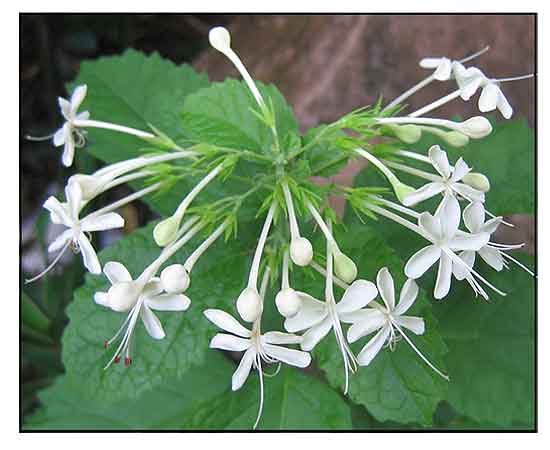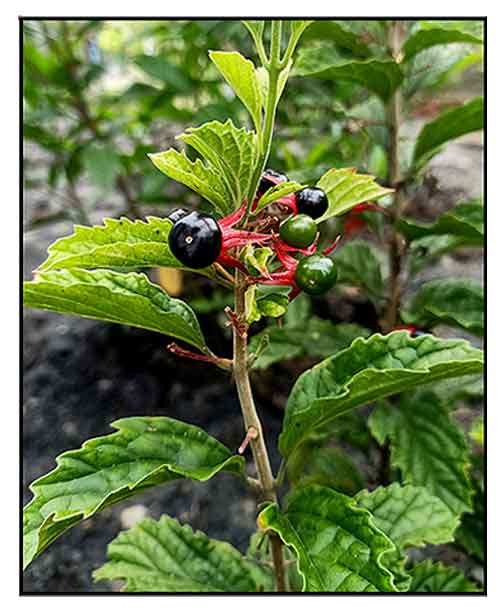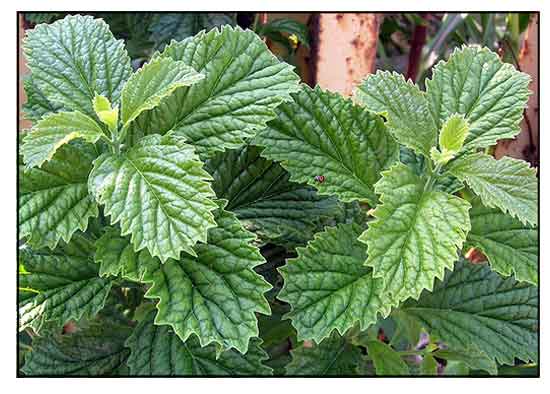
Family • Lamiaceae
Kalamitos
Bagauak-na-pula
Clerodendrum calamitosum L.
WHITE BUTTERFLY BUSH
Hua shi shu
| Scientific names | Common names |
| Clerodendrum calamitosum L. | Bagauak-na-pula (?) (Tag.) |
| Clerodendrum fastigiatum (W.Hunter ex Ridl.) H.J.Lam | Kalamitos (Tagalized) |
| Volkameria alternifolia Burm.f. | White butterfly bush (Engl.) |
| Volkameria fastigiata W.Hunter ex Riidl. | |
| Clerodendrum calamitosum L. is an accepted species: KEW: Plants of the World Online | |
| Other vernacular names |
| CHINESE: Hua shi shu. |
| DUTCH: Glaseterplant. |
| INDONESIAN: Keji beling, Gambir, Kembang bugang. |
| MALAY: Melur susun. |
Constituents Properties Studies Availability |
May 2025
![]()
 |
| PHOTOS / ILLUSTRATIONS |
| IMAGE SOURCE: Clerodenrum calamitosum / Vinayaraj / CC BY-SA 3.0 Unported / Image modified / Click on image or link to go to source page / Wikimedia Commons |
| OTHER IMAGE SOURCE: Clerodendrum calamitosum - Leaves / Hsiengan Huang 作者 / CC BY-NC 4.l0 International / Image modified / Click on image or link to go to source page / TaiEOL (Taiwan Encyclopedia of Life) |
| OTHER IMAGE SOURCE: Clerodendrum calamitosum - Fruiting leaves / SOCFINDO Conservation / Non commercial use / Click on image or link to go to source page / SOCFINDO Conservation |
| IMAGE SOURCE: Hedyotis costata / Subject Database of China Plant <http://www.naturemuseum.net/album/ShowPhoto.aspx?photoid=2671c974-77ca-44f9-b304-0f16660a06f7> Helixcn |
| OTHER IMAGE SOURCE: /Gliricidia sepium (Jacq.) Kunth ex Walp. - quickstick GLSE2 / Steve Hurst @ USDA-NRCS PLANTS Database / USDA |
| iNaturalistUK |
| IMAGE SOURCE: Erythrina fusca (Ngatae fisi) / Tau'olunga / CC BY-SA 3.0 / Click on image or link to go to source page / Wikipedia |
| Pacific Island Ecosystems at Risk (PIER) |
| Photos ©Godofredo Stuart / StuartXchange |
| Content © Godofredo Stuart / StuartXchange |
| Content / Photos © Godofredo Stuart / StuartXchange |
| Photos © Godofredo Stuart / StuartXchange |
Additional
Sources and Suggested Readings |
• |
DOI: It is not uncommon for links on studies/sources to change. Copying and pasting the information on the search window or using the DOI (if available) will often redirect to the new link page. (Citing and Using a (DOI) Digital Object Identifier) |
| List of Understudied Philippine Medicinal Plants |
| New plant names needed The compilation now numbers over 1,500 medicinal plants. While I believe there are hundreds more that can be added to the collection, they are becoming more difficult to find. If you have a plant to suggest for inclusion, native or introduced, please email the info: scientific name (most helpful), local plant name (if known), any known folkloric medicinal use, and, if possible, a photo. Your help will be greatly appreciated. |
• |
 |

 Gen info
Gen info • Shrub or undershrub about 1-3 ft tall. Rhizomatous, stem grayish or brown, subglabrous, branchlets slender, slightly pubescent, obtusely quadrangular. Leaves simple, opposite, elliptic-oblong, ovate, 3-15 x 1.5-8 cm across, base cuneate or rhomboid, lamina slightly tapering into the base, margin serrate-dentate to lobed, apex obtuse to acute, membranous, glabrous, above and slightly pubescent beneath, lateral veins 4-7 on either side of the midrib, impressed above and more prominent beneath, petiole slender, pubescent, canaliculated, 1.5-4 cm long, exstipulate. Inflorescence axillary solitary cyme, peduncle slender, dichotomous, pubescent. Flowers bisexual, zygomorphic, white, pedicellate about 0.5-1 cm long, calyx 5 toothed, deeply lobed, reddish tinged on green, lanceolate, minutely pubescent outside, corolla hypocrateriform, 5 lobed, narrowly obovoid, creamish white, corolla tube narrow, cylindric, about 2.5 cm long, pubescent outside, stamens 4, subequal to didynamous, exserted, filaments filiform, slender, anthers oblong, ovary superior, 4 lobed, style slender, slightly longer than the filaments, stigma bilobed, Fruit drupe globose, 5-8 mm in diameter, dark purple to black when mature. (I
• Shrub or undershrub about 1-3 ft tall. Rhizomatous, stem grayish or brown, subglabrous, branchlets slender, slightly pubescent, obtusely quadrangular. Leaves simple, opposite, elliptic-oblong, ovate, 3-15 x 1.5-8 cm across, base cuneate or rhomboid, lamina slightly tapering into the base, margin serrate-dentate to lobed, apex obtuse to acute, membranous, glabrous, above and slightly pubescent beneath, lateral veins 4-7 on either side of the midrib, impressed above and more prominent beneath, petiole slender, pubescent, canaliculated, 1.5-4 cm long, exstipulate. Inflorescence axillary solitary cyme, peduncle slender, dichotomous, pubescent. Flowers bisexual, zygomorphic, white, pedicellate about 0.5-1 cm long, calyx 5 toothed, deeply lobed, reddish tinged on green, lanceolate, minutely pubescent outside, corolla hypocrateriform, 5 lobed, narrowly obovoid, creamish white, corolla tube narrow, cylindric, about 2.5 cm long, pubescent outside, stamens 4, subequal to didynamous, exserted, filaments filiform, slender, anthers oblong, ovary superior, 4 lobed, style slender, slightly longer than the filaments, stigma bilobed, Fruit drupe globose, 5-8 mm in diameter, dark purple to black when mature. (I Distribution
Distribution